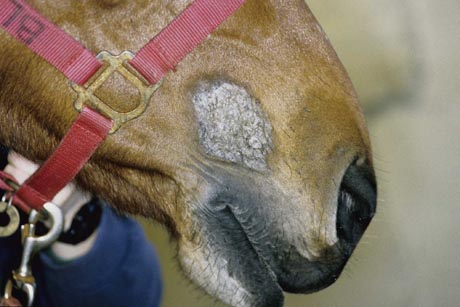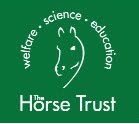Equine Sarcoid Researchers Find a Way to Inhibit Virus Protein in Lab; Clinical Trials Next
- March 10, 2017
- ⎯ Fran Jurga
by Fran Jurga | 12 January 2010 | The Jurga Report at Equisearch.com

A sarcoid can be masses of blister-like tumors or a single rough spot or wart-like growth. They vary tremendously and can easily be misdiagnosed and, consequently, mistreated.
What do you think are the most common health problems that readers ask about? Colic? Parasites? Vaccinations? Think again.
In the past few years, one very curious subject has topped the list: equine sarcoids. Horse owners chat politely about everything to do with horse care under the sun and then they almost hiss, “And is there anything new for sarcoids? I’ve got this horse and if only…”
Yes, if only. Sarcoids are one of those problems. One that could prevent a horse from fulfilling its athletic potential. Or from being ridden. Or from being pain-free.

But some great minds are working on this problem, and we have some news from the University of Glasgow in Scotland, where a multi-year research project funded by The Horse Trust seems to be coming to fruition.
The researchers have succeeded in killing equine sarcoid cells in vitro by silencing a gene in the virus that causes sarcoids. They now hope to obtain funding for clinical trials using the new technique, which could result in a more effective, non-toxic treatment for sarcoids.
Sarcoids are skin tumors caused by infection with the Bovine Papillomavirus (BPV) and they are the most common type of tumor found in horses. Although the disease is rarely life threatening, many horses with sarcoids are euthanized because the condition is untreatable or because the horse is unsellable. Currently there is no universally effective treatment for sarcoids and if treatment fails the sarcoids will often come back…with a vengeance.
The research, which was led by Professor Lubna Nasir of the University of Glasgow, found that by inhibiting the activity of a particular viral protein within sarcoid cells, the amount of viral DNA in the cells was reduced. This led to a reduction in the growth of the sarcoid cells and caused the cell to die by “programmed cell-death” (PCD). The researchers believe that PCD occurs because the sarcoid cells become reliant on the virus.
The research team inhibited the activity of a viral protein called E2, which is needed by BPV to replicate. They used a novel approach termed ‘gene silencing’ to suppress the activity of the gene that codes the E2 protein. The research was carried out in vitro on fibroblast cells, which had been cultured from sarcoid tissue removed from animals during surgery.

Some sarcoids could be mistaken for proud flesh. When a sarcoid grows on the inside of a horse’s leg, or over a joint, it can be painful during locomotion.
The researchers will now need to see if they can replicate the results in vivo, by developing a way of targeting the sarcoid cells in living horses.
“One of the challenges with gene silencing is administering it within (a) clinical setting – as you need to get molecules into every cell. As sarcoids are on the surface of a horse, we think administration should be relatively easy – potentially by injecting or applying a cream to the sarcoid,” said Professor Nasir. “If we are able to successfully develop this technique it would be a non-toxic and easy to administer treatment for horses affected by this distressing condition.”
Nasir’s research could also have an impact on the treatment of lesions in cattle, which are also caused by BPV. It may also help with the treatment of Human Papillomavirus (HPV) infections in humans. HPV, which is similar to BPV, can lead to various cancers in humans including cervical and vaginal cancer.

Some horses have a single localized sarcoid while others have masses on different parts of their bodies.
TO LEARN MORE: Information on sarcoids, their prevalence, appearance, diagnosis and treatment options can be found on the excellent University of Liverpool website: http://www.liv.ac.uk/sarcoids/index.htm. Over the years, I have referred countless people to this website and used it for reference myself. It’s a bookmark that I know by heart. I think it deserves an award for all the horses and horse owners who have found help there. It is the gift of Professor Derek Knottenbelt to the horse world. Don’t take it for granted; if you can, please donate to help continue research into equine sarcoids.
To refer to the research paper from the University of Glasgow, funded by The Horse Trust, here’s the reference that you’d look for on PubMed.gov or give to a librarian to find in the Virus Research Journal, which is published by Elsevier:
Gobeil PA, Yuan Z, Gault EA, Morgan IM, Campo MS, Nasir L. 2009. Small interfering RNA targeting bovine papillomavirus type 1 E2 induces apoptosis in equine sarcoid transformed fibroblasts.Virus Res. 2009 145(1):162-165.
Photos used in this blog post are from Professor Knottenbelt’s University of Liverpool equine sarcoids web site.
Follow @FranJurga on Twitter.com for more news and social media links for equestrians!





